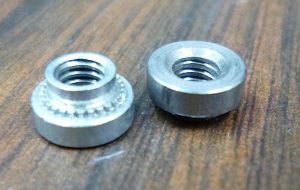
Swage nuts play an important role in the aerospace manufacturing industry. They are commonly used in conjunction with bolts to join sheet metal with components. Swage nuts allow for a strong and permanent anchor thanks to their ability to swage the sheet metal in which they are installed. To learn more about swage nuts and how they work, keep reading.
Overview of Swage Nuts
Also known as a self-clinching nut, a swage nut is a type of threaded fastener that’s characterized by the presence of a clinching ring. As shown in the image to the left, they feature as a similar design as other nuts, except swage nuts have a narrow band on the bottom. This narrow band, known as a clinching ring, is able to swage sheet metal during insertion.
When a swage nut is inserted into sheet metal, the sheet metal expands and deforms, thereby creating a strong and permanent anchor. Traditional threaded nuts, on the other hand, often create a weak and temporary anchor. In sensitive applications like aerospace manufacturing, swage nuts are preferable for this reason alone. Whether it’s aluminum or steel, swage nuts can be used with most types of sheet metal.
Origins of Swage Nuts
While swage nuts feature a simple design characterized by the presence of a clinching ring, they are a relatively new type of fastener. According to Wikipedia, American inventor Albert Spokes was responsible for pioneering the modern-day swage nut. In 1958, Spokes filed a patent with the United States Patent and Trademark Office (USPTO) for a nut featuring a clinching ring.
It’s important to note that conventional clinching nuts had been around prior to Spokes’ invention. Spokes, however, invented the first self-clinching nuts. Conventional clinching nuts required manual clinching from the opposite side. In comparison, swage nuts automatically clinch themselves upon insertion into sheet metal.
How Swage Nuts Work
To use swage nut, a manufacturing company must first drill a hole into sheet metal. Once the hole has been drilled, the swage nut can be inserted. During insertion, the swage nut will expand to create a strong and permanent anchor. This phenomenon is know is swaging, and it’s what distinguishes the swage nut from other types of threaded nuts.
Swag nuts are commonly used in applications where otherwise thin pieces of sheet metal will bear heavy loads. The self-clinching mechanism of this modern-day fastener allows for a stronger anchor than that of conventional nuts.
